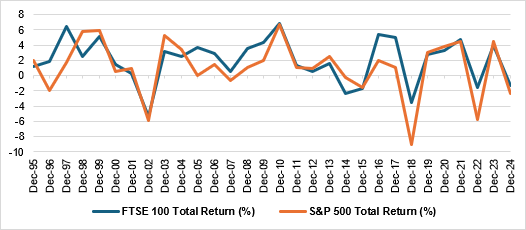Will there be a Santa rally this year?
A Santa rally this month could deliver a boost to the stock market and some festive cheer for your portfolio. But will investors see one this year?


Once December rolls around, there tends to be just one question on any seasoned investor’s mind: will we see a Santa rally this year?
The term ‘Santa rally’ refers to the tendency of stock markets to rise as the festive season kicks in and consumer spending rises. This also sees optimistic investors pile more into the top stocks and funds.
The FTSE 100 has returned 2.1% on average during December since 1984, making it the index’s best-performing month of the year. April and July are the only other months of the year with an average gain above 1% during that period.
MoneyWeek
Subscribe to MoneyWeek today and get your first six magazine issues absolutely FREE

Sign up to Money Morning
Don't miss the latest investment and personal finances news, market analysis, plus money-saving tips with our free twice-daily newsletter
Don't miss the latest investment and personal finances news, market analysis, plus money-saving tips with our free twice-daily newsletter
“If you want to know why markets talk about the Santa Rally, that is why – because the numbers back it up,” said Russ Mould, investment director at AJ Bell.
But while the Santa rally effect can make December a buoyant month for the stock market, Mould cautions that it often precedes a weaker year ahead.
“The FTSE 100 has served up 11 annual losses since 1984 and 10 of those came after a gain in the December of the previous year,” he said. “The only exception was 2015, whose 4.9% annual decline came after a 2.3% slide in December 2014.”
Some of the biggest historical Santa rallies have preceded sharp market downturns, such as the shock Federal Reserve rate hike in 1994 that followed a buoyant December 1993.
Last year (2024) was one of the rare cheerless Decembers for the FTSE 100, which fell 1.4% during the month. But as of the end of November, the index is up 18.9% this year – underscoring the point that dismal Decembers don’t necessarily mean an unhappy new year. In a separate article, we also take a look at where to invest for 2026.
How often do we see a Santa rally?
The data shows that stock markets do tend to rise during December. Analysis from Fidelity International shows that the FTSE 100 posted a positive return in December in 24 of the last 30 years, while the S&P 500 rose in 22 of the last 30 Decembers.

Why that happens is less clear. Jemma Slingo, pensions and investment specialist at Fidelity International, attributes the existence of Santa rallies to positive sentiment among investors at this time of year.
“Optimism tends to build as the year draws to a close and investors look ahead with a sense of renewal in the new year,” she said. “Festive optimism, Christmas bonuses and thinner trading volumes are often cited as contributing factors.”
Mould points out that in the past, investors looked forward to a ‘January effect’, wherein financial advisers would put their clients’ money to work in the new year and lift the stock market.
While this no longer happens, Mould thinks that the Santa rally effect may have originated with investors attempting to anticipate the January effect in advance.
Should you bank on a Santa rally this year?
Santa rallies are frequent occurrences, but like any seasonal investing trend, such as the ‘sell in May’ approach, they shouldn’t be relied upon too heavily.
“Seasonal patterns like the Santa rally are no substitute for a long-term investment plan, but they do offer an insight into how investor psychology can drive markets,” says Slingo. “Even in times of uncertainty – whether it’s financial crises, referendums or pandemics – December has often rewarded those who stayed invested rather than trying to time the market,” she added.
There are some reasons for festive optimism, though, particularly as far as the US stock market is concerned.
“With expectations firming of a December rate cut, and the US government shutdown resolved, at least a few obstacles to Rudolph’s flight path have been removed,” says Derren Nathan, head of equity research at Hargreaves Lansdown.
Slingo points out that while it has been a positive year for equities on the whole, with the UK and US both delivering double-digit gains, there are signs of nerves increasing as the VIX index – often referred to as the ‘fear gauge’ as it tracks stock market volatility – has risen sharply in recent weeks.
“While no one can predict whether the Santa Rally will return this December, history shows that investors who stay the course tend to be rewarded over time,” said Slingo. “The festive season can bring volatility and opportunity in equal measure, but discipline and perspective remain the best gifts investors can give themselves.”
Get the latest financial news, insights and expert analysis from our award-winning MoneyWeek team, to help you understand what really matters when it comes to your finances.

Dan is a financial journalist who, prior to joining MoneyWeek, spent five years writing for OPTO, an investment magazine focused on growth and technology stocks, ETFs and thematic investing.
Before becoming a writer, Dan spent six years working in talent acquisition in the tech sector, including for credit scoring start-up ClearScore where he first developed an interest in personal finance.
Dan studied Social Anthropology and Management at Sidney Sussex College and the Judge Business School, Cambridge University. Outside finance, he also enjoys travel writing, and has edited two published travel books.
-
 What are my retirement income options?
What are my retirement income options?We’re all told to save into a pension, but there’s widespread confusion about how to take an income from our savings and investments at retirement, a new study has found. We look at your retirement income options.
-
 UK interest rates: will the Bank of England lower rates?
UK interest rates: will the Bank of England lower rates?The Bank of England’s Monetary Policy Committee’s (MPC) final interest rates meeting of the year takes place tomorrow (18 December) and most experts expect a cut